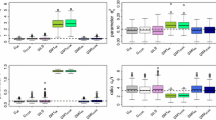Abstract
The ratio-correlation method of population estimation is shown to contain an inconsistent temporal relationship between the model’s empirical structure and its actual application. A simple transformation of the model’s variables is provided that eliminates the inconsistency. Two tests of the relative accuracy of the original and transformed models show that the transformed model achieves accuracy levels equal to or higher than the original. In one test, all nine years show a higher degree of accuracy, of which four are statistically significant. Several possible reasons are given for the increased accuracy shown by the transformed model. The transformation, termed the “rate-correlation” model, is recommended as a logical starting point in the examination of coefficient stability and spatial autocorrelation as well as a method for estimating small populations.
Similar content being viewed by others
References
Bogue, D. J. 1950. A Technique for Making Extensive Population Estimates. Journal of the American Statistical Association 45: 149–163.
Malec, D. and M. J. Katzoff. 1983. Application of Some Common Spatial Models to Population Data. Paper presented at the annual meeting of the American Statistical Association, Toronto, Ontario.
Mandell, M. and J. Tayman. 1982. Measuring Temporal Stability in Regression Models of Population Estimation. Demography 19:135–146.
Martin, J. H. and W. J. Serow. 1979. Virginia’s State-Local Cooperative Program: Conflict and Cooperation in Producing Population Estimates. State Government Autumn: 182–186.
Namboodiri, N. K. 1972. On the Ratio-Correlation and Related Methods of Subnational Population Estimation. Demography 9:443–453.
— and N. M. Lalu. 1971. The Average of Several Simple Regression Estimates as an Alternative to the Multiple Regression Estimate in Post Censal and Intercensal Population Estimation: A Case Study. Rural Sociology 36: 187–194.
O’Hare, W. 1976. Report on a Multiple Regression Method for Making Population Estimates. Demography 13:369–379.
—. 1980. A Note on the Use of Regression Methods in Population Estimates. Demography. 17:341–343.
Ord, K. 1975. Estimation Methods For Models of Spatial Interaction. Journal of the American Statistical Association 70:120–126.
Schmitt, R. C. and A. H. Crosetti. 1954. Accuracy of the Ratio-Correlation Method for Estimating Postcensal Population. Land Economics 30:279–281.
— and J. M. Grier. 1966. A Method of Estimating the Population of Minor Civil Divisions. Rural Sociology 31:355–361.
Serow, W. J. and J. H. Martin. 1977. Estimating Demographic Characteristics Using the Ratio-Correlation Method. Demography 15:223–233.
Shryock, H. S. and J. S. Siegel. 1973. The Methods and Materials of Demography. Second Printing (Revised). Washington, D.C.: U.S. Government Printing Office.
State of Washington. 1979. Population Trends, 1979. Olympia, Washington: Office of Financial Management.
Swanson, D. A. 1978. An Evaluation of “Ratio” and “Difference” Regression Methods for Estimating Small, Highly Concentrated Populations: The Case of Ethnic Groups. Review of Public Data Use 6:18–27.
— 1980. Improving Accuracy in Multiple Regression Estimates of Population V sing Principles from Causal Modelling. Demography 17:413–427.
— 1981. Allocation Error in Population Estimates: An Overlooked Criterion With Fiscal Implications. Pp. 13–21 in Small Area Population Estimates: Methods and Their Accuracy and New Metropolitan Area Definitions and Their Impact on the Private and Public Sector, Series GE-41, No.7. Washington, D.C.: U.S. Bureau of the Census.
U.S. Bureau of the Census. 1973. Federal-State Cooperative Program for Local Population Estimates—April 1, 1970. Current Population Reports, Series P-26, No. 21 (April).
Zitter, M. and H. S. Shryock. 1964. Accuracy of Methods of Preparing Postcensal Population Estimates for Local Areas. Demography 1:227–241.
Author information
Authors and Affiliations
Rights and permissions
About this article
Cite this article
Swanson, D.A., Tedrow, L.M. Improving the measurement of temporal change in regression models used for county population estimates. Demography 21, 373–381 (1984). https://doi.org/10.2307/2061166
Issue Date:
DOI: https://doi.org/10.2307/2061166




